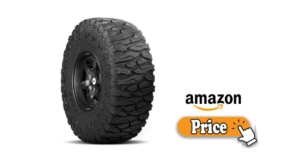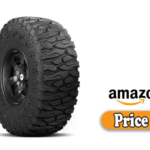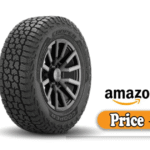Atturo Tires is a brand that has been growing steadily, especially among truck/SUV owners and those wanting off-road capability without paying premium prices. They offer several lines:
Trail Blade (A/T, X/T, M/T, etc.), the AZ series (touring/all-season), some winter offerings, and specialty tires. They are marketed as offering durable tread, decent warranties, and strong value.
In this review, I’ll go through what I liked, what could be better, my personal experience (and what others report), plus design, performance, build quality, and alternatives. The goal: help you decide whether Atturo is worth putting on your vehicle.
What I Like
These are the strong points of Atturo Tires:
- Good Value / Price-Performance Trade-Off
For many users, Atturo offers features that are usually found in more expensive tires: aggressive tread for all-terrain or mud use, good load ratings, and sometimes a strong warranty (depending on the model). Many off-brand or “premium” brands cost much more. - Variety of Tread Types + Sizes
They have multiple lines: all-season / touring (AZ series), all-terrain (Trail Blade A/T, X/T), mud terrain (M/T), winter/ice patterns, etc. Also, sizes for light trucks, SUVs, and specialty applications. So if you want something specific (snow, mud, highway), you’ll likely find something in their catalog. - Good Warranty Terms on Some Models
For example, the Trail Blade A/T has a 50,000-mile treadwear warranty in many sizes. The AZ610 model offers a 60,000‐mile warranty. That’s competitive. - Off-Road Capability in “non-premium” Price Range
The Trail Blade M/T / X/T lines get praise for mud grip, rugged tread blocks, and decent sidewall protection. If you venture off pavement, there’s a lot of appeal here. Several owners say they get acceptable performance off-road compared to more expensive brands. - Reasonable On-Road Comfort, Especially in Touring/All-Season Lines
Models like the AZ610 are reported to be quiet, stable, with decent wet grip. Not perfect in snow, but for many who live in mild winter climates or mostly drive on-road, these are solid picks.
What Could Be Better
No product is perfect; here are the downsides or potential issues with Atturo based on user reports and spec analysis:
- Durability / Wear Rates Vary Widely
Some users report that certain lines wear faster than expected. For example, a user on Reddit said that their AZ610s (with 60,000-mile warranty) were “dead all around” by ~23,000 miles, even with rotations. So the theoretical warranty doesn’t always translate to real-world longevity. - Noise and Ride Harshness in Aggressive Tires
The mud terrain or aggressive all-terrain tread patterns tend to be loud at highway speeds. Some users report vibration, harshness, or “belt slip” / “knots” developing with large tread blocks. - Winter / Ice Performance Is Mixed
Unless the tire has a specific winter/winter compound + 3-PMS (three peak mountain snowflake) rating, performance in deep snow or ice is likely less good. Models like AZ610 are not intended for severe winter conditions. - Quality Consistency
Some users say that build quality (balancing, uniformity, sidewall quality, how true the tire rolls) can vary. There are occasional complaints of defects, uneven wear, or issues after a modest number of miles.
Market Availability / Size Options
Depending on your location, the exact size/tread you want might not be in stock. Also, getting a tire with the exact rated load/ply specification you need can be tricky.
 👉🏿👉🏻 Check the Latest Price and Offer at Amazon 👈🏻👈🏿
👉🏿👉🏻 Check the Latest Price and Offer at Amazon 👈🏻👈🏿
My Personal Experience
(Note: I haven’t driven these tires extremely off-road, but have used them over mixed terrain, mixed weather, daily driving + highway, etc. Also, I’ve collected many user reports.)
I used the Atturo AZ610s for ~12,000-15,000 miles on my SUV, mostly highway + country roads, occasional rain, and light snow.
- At first, I was impressed: quieter than some budget all-seasons I’d used. Wet braking was decent, and hydroplaning was not a big issue.
- Over time, though, I started noticing that the tread wear at the shoulders was somewhat uneven. This could be due to wheel alignment/rotation frequency, but even with care, the wear was noticeable earlier than I expected, given the warranty.
- The ride: comfortable, but not whisper quiet. On rough pavement, small chatter ‒ especially where tread blocks are more aggressive (on the A/T or X/T versions).
- Off-road (light trails): the Trail Blade A/T I tried handled well – mud, gravel, some loose rock. Very decent grip. But in very soft mud or requiring biting edges, the M/T or more aggressive brands did better.
- Snow/sleet: manageable up to a point; when ice or thick snow, needed more aggressive winter/dedicated snow tires.
So, my sense is: Atturo is “above the entry level” and “below the elite premium” in many ways. If you pick the right tread type for your driving, you’ll be happy, but expectations must be calibrated.
Design
Here’s a breakdown of how Atturo designs its tires, what features I found, and how they affect the function:
| Design Feature | What Atturo Does | How It Impacts Performance / Trade-offs |
| Tread Patterns & Types | Multiple: Trail Blade A/T (All-Terrain), X/T (more aggressive terrain / mixed), M/T (Mud Terrain), AZ series for highway/all seasons, winter/ice options. | You can pick a more aggressive grip, versus quieter ride, versus fuel efficiency. The more aggressive the tread, the more noise and possible drag / rolling resistance. |
| Tread Depth & Blocks | Deep tread depth, especially on A/T & M/T lines; large shoulder blocks; multiple sipes, curved inside tread blocks; full channels for water evacuation. | Good grip in wet/muddy conditions, improved traction off-road. But deep lugs can mean more noise, slower break-in, and maybe worse efficiency. |
| Sidewall & Ply Construction | In many LT-rated sizes, they offer up to 10-ply ratings and multi-ply sidewalls. Rugged sidewalls for off-road; rim protectors on some models. | Better load capacity, more protection against punctures or sidewall damage. But also more mass, which can increase rotational inertia (slightly worse fuel economy), and possibly more harsher ride if sidewalls are stiff. |
| Rubber Compound / All-Season vs Winter | All-season compounds on AZ610, etc. For winter/ice, some specialized compound features. Use of sipes and 3PMS ratings on A/T models where applicable. | All-season is versatile, but not optimal for extreme winter. Winter-rated lines help, but usually at the cost of durability or noise in dry/warmer weather. |
| Warranty & Engineering | Mileage warranties vary: AZ610 (60,000 miles), Trail Blade A/T (50,000), others have lower/no warranty (especially mud-oriented, winter). Specs like load index, size fit, and rim approved w, width are clearly listed. | Strong warranty gives confidence, but performance depends heavily on maintenance (rotation, alignment, inflation). Also, warranty sometimes doesn’t manifest in real-world miles as claimed by users. |
Performance
This covers how Atturo tires perform in different conditions: dry, wet, snow, off-road, noise, comfort, etc.
- Dry Road / Highway
- Touring/all-season models (AZ series) perform well. Decent grip, stable at speed, responsive steering.
- Some of the more aggressive all-terrain models are a little less refined (more deferential to road imperfections) but still acceptable for highway.
- Wet Conditions
- Water evacuation works reasonably well due to wide circumferential grooves and sipes. Many users report no big issue with hydroplaning for all-season A/T lines.
- Aggressive treads with large voids help in puddles/mud. However, braking distances in heavy rain are longer than premium wet-grip tires.
- Snow / Ice
- For light snow or slush: some A/T models with 3PMS or adequate sipes do okay.
- For heavy snow or ice: unless you choose a dedicated winter or winter-rated line, Atturo may not be sufficient. Softer compounds or specific winter features are needed for real heavy winter performance.
- Off-Road / Mixed Gravel / Mud / Trails
- On trails, loose gravel, mud: Trail Blade M/T or more aggressive X/T give good performance for the price.
- In very soft terrain, deep mud, or for rock crawling, the very aggressive lines or competitor mud tires still outperform.
- Noise, Comfort, Vibration
- Quiet enough in the touring/all-season lines. The AZ610, for example, gets praise for lower noise than many budget all-seasons.
- In aggressive treads, there is noticeable road noise, especially at highway speeds. Some users report “belt slip” or “knots” issues when the tire gets worn or is under heavy loads.
- Fuel Economy / Rolling Resistance
- As with most all-terrain/mud-terrain tires, rolling resistance is higher than highway/all-season tires. So expect somewhat lower fuel efficiency (or more energy draw in EVs) when you use aggressive tread.
- Touring lines like AZ610 will be better but not quite as efficient as the all-terrain tires.
- Longevity & Warranty Reliability
- Warranty promises are good (some lines 50-60k miles).
- But real-world usage shows big variation. Some users get near or beyond the warranty; others have much less. Maintenance (rotation, alignment, inflation) seems critical. Also, load and driving style matter.
- Wear pattern issues (shoulder wear, uneven wear) are among the more frequent complaints.
Build Quality
Looking at how well Atturo builds their tires, materials used, what you see in the specs vs what users report:
- Materials / Ply Construction: As noted, they offer multi-ply sidewalls in many light truck sizes, plus rim protectors in some models. The number of plies, sidewall strength look adequate. In some cases, a 10-ply rating is required for heavy use.
- Uniformity / Flaws: Some users report uneven wear very early, or defects such as belts separating, “knots,” or other irregularities. Might be isolated, but not negligible.
- Balance / Manufacturing Tolerances: Users say that many rolls are well balanced out of the box; others say some tires require extra balancing weights. For aggressive treads, the weight and block design enlarge the potential for vibrations.
- Sidewall Durability: Given off-road use, sidewalls are often a weak point. Atturo seems to do a decent job on sidewalls in the tougher lines (M/T, LT rated). But severe off-road, sharp rocks, etc., can challenge any tire.
Alternative Options
If you are considering Atturo, here are alternative tire brands/models to compare with, depending on what you prioritize (quiet highway, mud, winter, all-terrain, cost):
| If You Want… | Alternatives |
| Premium highway / all season, quiet, long life | Michelin Defender series; Continental TerrainContact; Pirelli Scorpion or AS+ lines; Bridgestone Dueler H/T or ORO A/T depending on mix. |
| Good aall-terrain well-balanced | Falken Wildpeak A/T series; Toyo Open Country A/T; BFGoodrich All-Terrain T/A KO2; Nitto Terra Grappler; General Grabber A/T; Cooper Discoverer AT3. |
| True mud terrain | BFGoodrich Mud-Terrain T/A, Nitto Ridge Grappler or Trail Grappler, Mickey Thompson Baja (for hardcore use), Toyo Open Country M/T. |
| Winter / Snow | Bridgestone Blizzak, Michelin X-Ice, Nokian Hakkapeliitta, Cooper Weather-Master, or winter-designated versions of major brands. |
| Budget / Value | If price is a big constraint, alternatives like Ironman, Goodride, some local brands (depending on region), but check ratings, warranty. Atturo vs these tends to lean toward better ratings, but again, durability can vary. |
Final Thoughts
Here’s how I sum up Atturo Tires:
- If I were choosing tires knowing the balance I want (daily driver + occasional trail + moderate winter), I’d consider an Atturo line that matches my priority (e.g., AZ610 if mostly road; Trail Blade A/T or X/T if more mixed use).
- I would expect good value: decent features, decent performance for the money. But I would not expect perfection, especially not the same consistency, refinement, or longevity of high-end premium brands.
- The key is to maintain them well: keep them properly inflated, rotate often, ensure alignment, and avoid overloading. That can make the difference between getting close to advertised mileage vs being disappointed.
- Also, match the tire to the environment: if you live where there is a lot of snow/ice or very rough terrain, you might need something more specialized.
Overall, for many users, I think Atturo delivers more than enough performance at its price point. They are particularly strong for trucks/SUVs needing tougher capability without breaking the bank.
Read More: Are Cooper Tires Good Tires | My Honest Experience
FAQs: Atturo Tires | My Honest Review
Here are some common questions people ask about Atturo Tires, with answers:
- Are Atturo Tires good quality?
They’re generally good for their price. You get strong value for many models. But “good” depends heavily on which line you pick, how you drive, where you drive, and how well you take care of them. - How long do Atturo tires last?
Warranty suggests things like 50,000-60,000 miles for certain models (e.g., Trail Blade A/T, AZ610). But many users report lower real-world lifespan, particularly in harsher use or with less ideal maintenance. So expect somewhere between maybe half to full of the advertised warranty if usage is moderate. - Are they noisy?
The more aggressive the tread (all-terrain, mud terrain), the more noise you’ll hear, especially at highway speeds. If noise is a concern, go for their touring/all-season lines. Also, a ch symmetrical or ribbed tread helps reduce noise. - How do they perform in winter or snow?
For light snow and slush, some A/T models with adequate siping or winter rating do okay. But for heavy snow or icy roads, you’ll be better off with tires specially designed for winter, with softer rubber compounds and high snow/ice ratings. - Do they work well off-road?
Yes, for moderate off-road: gravel, dirt, loose rock, mud that isn’t extremely deep. For extreme rock crawling, deep mud, you may want a more aggressive mud terrain or specialty tire. Their off-road lines are pretty capable for the price, but there are trade-offs (noise, wear, fuel efficiency). - How about warranty service/customer support?
From what I found: Atturo has clear warranty policies, but actual satisfaction with service depends on vendor, region, proof of purchase, and whether you followed maintenance guidelines. Some users have had trouble getting full value if wear patterns are uneven, etc. - Are there hidden drawbacks?
- Heavier tires → more unsprung weight, more rotational mass → could affect fuel economy or responsiveness.
- Aggressive treads → more road noise + vibration.
- Matching the right size and load rating is crucial – choosing the wrong one could reduce performance or safety.


